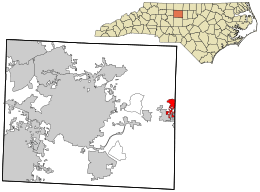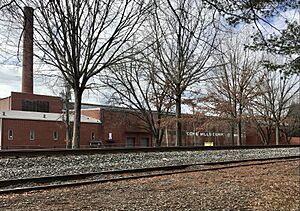Gibsonville, North Carolina facts for kids
Quick facts for kids
Gibsonville
|
|
|---|---|

Main Street
|
|
| Nickname(s):
"City of Roses"
|
|

Location in Guilford County and the state of North Carolina.
|
|
| Country | United States |
| State | North Carolina |
| Counties | Guilford, Alamance |
| Founded | 1855 |
| Incorporated | 1871 |
| Named for | Joseph Gibson |
| Area | |
| • Total | 3.96 sq mi (10.26 km2) |
| • Land | 3.94 sq mi (10.19 km2) |
| • Water | 0.03 sq mi (0.06 km2) |
| Elevation | 705 ft (215 m) |
| Population
(2020)
|
|
| • Total | 8,920 |
| • Density | 2,266.84/sq mi (875.13/km2) |
| Time zone | UTC-5 (Eastern (EST)) |
| • Summer (DST) | UTC-4 (EDT) |
| ZIP code |
27249
|
| Area code(s) | 336 |
| FIPS code | 37-25980 |
| GNIS feature ID | 2406565 |
Gibsonville is a town in North Carolina, a state in the United States. It's known as the "City of Roses." The town is located in both Alamance and Guilford counties. Most of Gibsonville is part of a larger area that includes cities like Greensboro and Winston-Salem. In 2020, about 8,971 people lived in Gibsonville.
Contents
History of Gibsonville
Gibsonville started thanks to a man named Joseph Gibson (1785-1857). His family had been farming and even mining for gold in the area since 1775. In 1851, Joseph Gibson helped build the new North Carolina Railroad (NCRR) by preparing the land. Soon after, Gibsonville began to grow as a place for trade and business.
The first train arrived in Gibsonville on October 9, 1855. The train station was named Gibson Station to honor Joseph Gibson. Later, on February 18, 1871, the state officially recognized Gibsonville as a town.
Early Days and Gold Mining
Gold mining was a small part of Gibsonville's early history. Gold was found on Gibson Hill, south of town, in the early 1800s. In 1888, a company called Chifar Consolidated Gold Mine Company started crushing gold ore near the train station. The town cemetery is in this area, but no gold has ever been found in graves.
One of the first stores in town was owned by Captain Billy Gilmer. He built his wooden general store before 1860. It was located where Reno's Pizza is today. During the gold rush, Gibsonville had several saloons, making it a lively and somewhat wild town.
The area near the train station, called Depot Greens, was used to hold farm animals and crops. These goods were then shipped out by train. The railroad was very important for Gibsonville's economy.
Growth with Textile Mills
In 1886, a local builder named Berry Davidson built the Minneola textile mill on Railroad Avenue. This mill used steam power to make cloth. He later built another mill, the Hiawatha textile mill, in 1893. These mills changed Gibsonville from a farming town into a busy place with factories.
In 1894, Dr. Jordan built the first two-story brick building downtown. It is now where Wade's Jewelry is located. Other brick buildings facing the Greens were built between 1905 and 1920. The early 1920s were a time of great growth for Gibsonville. Main Street was paved, and the town got water, sewer lines, and street lights. Many old wooden buildings were replaced with the brick ones you see today.
Before 1912, important citizens like A. B. Owens, J.W. Burke, and D. M. Davidson started the Gibsonville Development Company. They helped create the town's telephone system, a bank, a lumber yard, and the Gibsonville Hosiery Mill. They also expanded the Rock Creek Dairy, which became the largest dairy in the state.
Modern Gibsonville
The town's population grew slowly at first, from 111 people in 1890 to over 6,410 in 2010. Most of the fast growth happened after 1970. When the textile mills closed in the 1980s, Gibsonville changed. It became a community where people live and then travel to work in nearby cities like Burlington and Greensboro.
Gibsonville has been called the "City of Roses" since at least 1920. This is because train passengers could see many rose bushes growing along the railroad tracks near the Minneola Mill.
Some important buildings in Gibsonville are listed on the National Register of Historic Places. These include the Gibsonville School, Francis Marion Smith House, and Simeon Wagoner House.
Geography of Gibsonville
Gibsonville covers about 3.9 square miles (10.1 square kilometers) of land. A very small part of the town is water.
The town is almost equally divided between Alamance and Guilford counties. However, it is closely connected to the town of Elon and Elon University in Alamance County. Joseph Gibson, who the town is named after, was a well-known farmer from Guilford County. His old house is still near Gibsonville and is a recognized landmark.
Population and People
| Historical population | |||
|---|---|---|---|
| Census | Pop. | %± | |
| 1880 | 111 | — | |
| 1900 | 521 | — | |
| 1910 | 1,162 | 123.0% | |
| 1920 | 1,302 | 12.0% | |
| 1930 | 1,605 | 23.3% | |
| 1940 | 1,753 | 9.2% | |
| 1950 | 1,866 | 6.4% | |
| 1960 | 1,784 | −4.4% | |
| 1970 | 2,019 | 13.2% | |
| 1980 | 2,865 | 41.9% | |
| 1990 | 3,441 | 20.1% | |
| 2000 | 4,372 | 27.1% | |
| 2010 | 6,410 | 46.6% | |
| 2020 | 8,971 | 40.0% | |
| 2022 (est.) | 9,075 | 41.6% | |
| U.S. Decennial Census | |||
Who Lives in Gibsonville?
As of the 2020 United States census, there were 8,920 people living in Gibsonville. These people made up 2,481 households and 1,895 families.
The table below shows the different backgrounds of people living in Gibsonville in 2020:
| Race | Number | Percentage |
|---|---|---|
| White (non-Hispanic) | 5,830 | 65.36% |
| Black or African American (non-Hispanic) | 1,920 | 21.52% |
| Native American | 23 | 0.26% |
| Asian | 168 | 1.88% |
| Other/Mixed | 417 | 4.67% |
| Hispanic or Latino | 562 | 6.3% |
Famous People from Gibsonville
Gibsonville is home to some well-known individuals:
- Sisters Kay Yow and Deborah Yow grew up in Gibsonville. Kay Yow was a famous women's basketball coach at N.C. State, and Deborah Yow was an athletic director.
- NFL football players Torry Holt and his brother Terrence Holt are also from Gibsonville. Torry played for the Rams and Jaguars, and Terrence played for the Lions, Cardinals, Bears, Panthers, and Saints.
See also
 In Spanish: Gibsonville (Carolina del Norte) para niños
In Spanish: Gibsonville (Carolina del Norte) para niños




